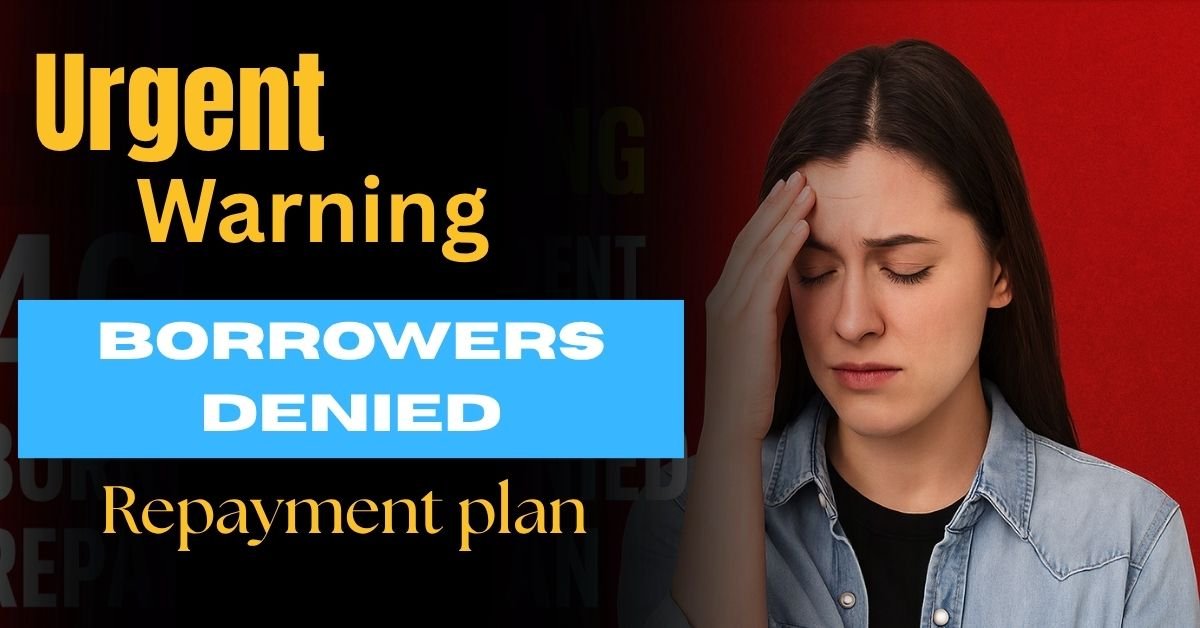460K student loan borrowers to be denied repayment plan
Biden administration in 2023 proposed the SAVE plan (Saving on a Valuable Education) which followed the thwarted the mass student debt forgiveness plan. It aimed to ensure that loan repayment is affordable because monthly payments are limited to up to 5 percent of discretionary income on undergraduate loans and 10 percent on graduate loans which is relatively low as compared to the previous alternatives.
How SAVE Differed from Other IDR Plans
In exchange, unlike all other available income-driven repayment (IDR) plans such as PAYE or IBR, the SAVE Plan was intended to automatically cancel remaining after only 10 years of repayment, abolish any accruing interest, and enable minimum- and even zero-income earners to pay nothing/month in some cases. This rendered it as the cheapest plan ever- until it was stopped.
What Triggered the Denial of 460,000 Applications?
Legal Block by Courts in June 2024
Courts ruled the SAVE Plan unlawful in the middle of 2024, claiming executive overreach as well as preventing servicers to enroll new borrowers. The execution of the plan stopped.
Misidentification of Repayment Options by Borrowers
To apply to IDR many borrowers (460,000 of them) used to choose the option of the lowest monthly payments but which most of them ended up termed as SAVE. However, since SAVE was blocked these applications could not be processed. The Department of Education put out the news of denying such applications, which left confusion and uncertainty.
Impact on the 1.5 Million Borrower Backlog
SAVE Plan Confusion in Application Forms
In the case of IDR application user interface, the SAVE option was not always clearly distinguished within the rest of the plans. Consequently, borrowers ended up choosing SAVE by mistake, believing it was a generic car payment option of the lowest amount possible.
Breakdown of Affected Demographics
Reports indicate that this group of 460,000 is 31 percent of the 1.5 million IDR application backlog. Majority of them are low- to middle-income borrower- the target audience of SAVE.
Alternatives to the SAVE Plan for Income-Driven Repayment
Overview of IBR, PAYE, and ICR Plans
Borrowers can still access other repayment plans:
- Income-Based Repayment (IBR): 10-15% of discretionary income.
- Pay As You Earn (PAYE): 10% with 20-year forgiveness.
- Income-Contingent Repayment (ICR): 20% or fixed payment based on income.
How to Apply or Switch Plans Efficiently

Borrowers should log into studentaid.gov, explore the repayment estimator, and submit a new IDR request choosing IBR, PAYE, or ICR. Paper applications may process faster due to system bottlenecks.
Why Student Loan Servicers Are Struggling to Keep Up
Application Processing Delays
Only 79,000 IDR applications were processed in April 2025, while nearly 2 million remain in the queue. Limited staffing, outdated infrastructure, and SAVE-related confusion have contributed to delays.
Staffing Shortages and System Limitations
Major servicers like MOHELA and Aidvantage face backlogs due to staffing constraints and a lack of clear guidance following SAVE’s court block.
What Borrowers in Forbearance Should Expect Next
Interest Resumption Starting August 1, 2025
The Department of Education will begin charging interest again on SAVE loans currently in forbearance—even though these borrowers haven’t made payments.
Lack of Progress Toward Forgiveness
This period doesn’t count toward forgiveness milestones like PSLF or IDR forgiveness, further delaying relief.
The Political Landscape: Biden vs. Trump Administration on Student Loans
SAVE as a Pivot After Supreme Court Blocked Forgiveness
SAVE became an alternative to the original forgiveness plan after the Supreme Court blocked another proposal set by Biden. It was made to avoid the legal challenges.
Trump’s Reconciliation Law and Simplification Plans
The SAVE Plan is being destroyed in President Trump under his new education policy. Instead, it will replace with two less complex repayment alternatives, although this is unclear.
Borrower Advocacy and Legal Pushback
Criticism from Student Debt Relief Organizations
Organizations such as the Student Borrower Protection Center caution that the stalled SAVE and the renewed interest may result in higher defaults rates and poor financial conditions.

Public Pressure to Reverse SAVE Denial and Interest Resumption
Policymakers such as Senators Sanders and Warren as well as other lawmakers have requested the Education Department to revoke the decision and postpone interest accrual until adequate and reasonably affordable repayment plans become available.
How to Know If You Are One of the 460,000 Affected
Steps to Check Your Loan Status
If you applied for an IDR plan after 2023, you may be among the affected. Here’s how to find out:
- Log into your Federal Student Aid account at studentaid.gov.
- Go to the “Loan Management” section.
- Look for terms like “SAVE,” “lowest monthly payment,” or “application pending.”
- Check for communications from your loan servicer—especially emails or portal messages about application denial or forbearance status.
Key Indicators You Selected SAVE Inadvertently
- You clicked “lowest payment possible” without selecting a specific plan.
- Your loan status shows “forbearance due to legal block.”
- No payment requirement has appeared on your dashboard in recent months.
When any of these is seen, chances are high that you are among the 460,000 whose applications have been declined as a result of it being legally terminated.
Consequences of Higher Payments and Missed Forgiveness Credits
Compounded Interest Issues
With interest resuming on August 1, 2025, loans in SAVE forbearance will begin accruing charges—even though no payments were required previously. This means:
- Your total balance could grow significantly.
- You may face “interest capitalization,” where unpaid interest gets added to your loan principal.
- Monthly payments could increase, especially if your income has changed.
Delayed Eligibility for Debt Cancellation
Because time spent in SAVE forbearance does not count toward:
- Public Service Loan Forgiveness (PSLF)
- 20-25 year IDR forgiveness milestones
Borrowers essentially lose time toward eventual loan cancellation, meaning more years of repayment and greater overall cost.
Urgent Steps to Take Before August 2025
Choosing a Different IDR Plan
Act quickly to apply for one of the legally recognized IDR plans:
- Visit studentaid.gov/idr to start a new application.
- Use the Loan Simulator Tool to estimate payments across available plans.
- Avoid selecting “lowest payment” unless it gives specific plan options.
Contacting Loan Servicers for Help
Reach out directly to your servicer (e.g., MOHELA, Aidvantage, Nelnet):
- Ask for guidance on available IDR plans.
- Request application status updates.
- Ask about retroactive application options or possible interest waivers.
Document every communication for your records.
Should You Consider Loan Consolidation?
Benefits and Drawbacks
Pros:
- Clears old loans and resets repayment timelines.
- May allow you to access IDR plans not available on older loans.
- Simplifies tracking and servicing.
Cons:
- Resets your forgiveness timeline (you start over at 0).
- In some cases, could raise your interest rate (weighted average rounded up).
Eligibility and Process Overview
You’re eligible for Direct Consolidation if you have:
- Multiple federal loans
- Older FFEL or Perkins loans
Apply at studentaid.gov/consolidation. Processing takes 30–60 days, so act fast if you’re affected.
Expert Insights from Student Loan Professionals
Statements from the Student Loan Servicing Alliance
Scott Buchanan, Executive Director of the Student Loan Servicing Alliance, said:
“It’s difficult to determine whether borrowers knowingly selected SAVE. Many just wanted the lowest payment. We recommend they reapply for another IDR plan.”
Insights from Borrower Protection Groups
Persis Yu, Deputy Executive Director at the Student Borrower Protection Center, noted:
“For many, this time in forbearance doesn’t count toward forgiveness. Borrowers could end up paying thousands more if they don’t act before interest resumes.”
Borrower Stories: Real-Life Experiences of SAVE Applicants
Common Challenges Faced During the Application
Borrowers have reported:
- Misleading language in IDR application forms
- No clear distinction between SAVE and other plans
- Months of uncertainty without any official updates
Quotes from Impacted Borrowers
“I applied in good faith, thinking I’d start making $0 payments. Now I’m told I never really enrolled in anything,” says Monica D., a graduate student from Ohio.

“I’m stuck in forbearance limbo. It’s like watching your loan balloon while you’re frozen,” shares Bryan L., a public school teacher in Florida.
Resources and Tools to Help You Navigate Repayment
| Tool/Resource | Purpose | Website |
|---|---|---|
| Loan Simulator Tool | Estimate payments and choose plans | studentaid.gov/loan-simulator |
| IDR Application Portal | Submit repayment plan requests | studentaid.gov/idr |
| Federal Student Aid Info Center | Phone support: 1-800-433-3243 | studentaid.gov/help-center |
| Student Borrower Protection Center | Advocacy and legal help | protectborrowers.or |
Frequently Asked Questions (FAQs
1. Why were 460,000 student loan applications denied?
They were tied to the SAVE Plan, which was blocked by courts in June 2024 and deemed illegal for servicers to process.
2. How do I know if I’m affected?
Log into your FSA account. If your application says “forbearance” with no plan listed or if you selected the “lowest payment option,” you might be affected.
3. Will my time in SAVE count toward forgiveness?
No. Time in SAVE forbearance does not count toward PSLF or IDR forgiveness milestones.
4. What happens after August 1, 2025?
Interest will resume on affected loans, potentially increasing the total you owe if you remain in forbearance.
5. What plan should I switch to now?
Consider applying for IBR, PAYE, or ICR through studentaid.gov/idr.
6. Can I get retroactive credit for forgiveness?
Possibly. Some past reforms allowed retroactive credit. Ask your servicer or review the IDR Account Adjustment guidelines for details.
Conclusion: Charting a New Course for Student Loan Repayment
Are you the one of the 460,000 borrowers who have been affected with the latest SAVE Plan denial? Well, you are not alone, and you still have choices. Being proactive and changing plans, reaching out to your loan servicer, and keeping updated can avoid thousands of dollars of extra expenses. With change in the student loan system yet again, the borrowers should be alert, active and powerful.
Braj Verma is a resident of Rajgarh in Madhya Pradesh and is a content writer and freelancer by profession. He has a degree in Political Science from Barkatullah University, Bhopal. He has expertise in subjects like credit cards, banking, loan, insurance, political analysis and digital marketing.

